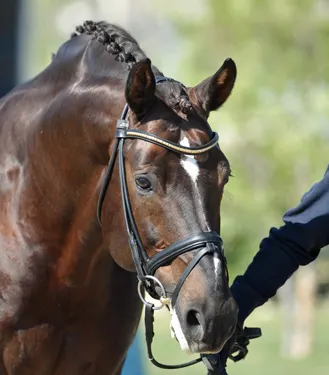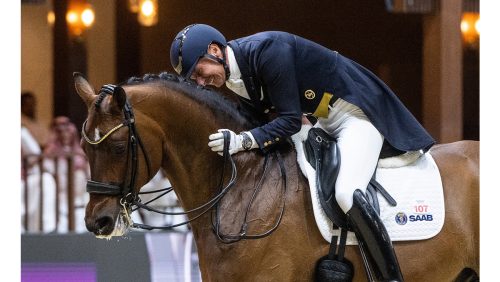You have decided to enter some dressage shows this summer! Your horse is going well, you have memorized your tests, and your entries are all filled out.
And then you take a good look at your horse….It seems he is channeling his inner fuzz monster—he’s growing a beard, you could braid the hair on his legs, and his tail looks like something a chimney sweep could use.
Liv Gude of Pro Equine Grooms tells you how to take your dressage horse from wild and fuzzy to show ring sleek in just a few steps!
Let’s start at the tail and work forward. Before you scan ahead and think that this huge list will take you hours and hours—it won’t! A few minutes each for a few days is all you need.
For a dressage horse, you can bang your horse’s tail at the bottom. This creates a sleek look to the tail, helps the tail appear fuller, and highlights the action of your horse’s hind legs. Because a dressage judge will be looking closely at your horse’s hind legs, it’s important to tidy a shaggy tail and not create a frizzy distraction.
You can also trim the top of your horse’s tail to rein in the shorter hairs that sometimes like to mimic a clown wig. You could trim the tail top with scissors or clippers along the sides, or use a pulling technique to remove the wayward hair. This serves to create a clean and tidy picture, as well as accentuate your horse’s rump muscles.
About those wispy legs—even if your horse has shed his winter coat, he may still have some longer hairs down the back of his legs and fetlocks. Many dressage horses arrive in the show ring with clipped legs from the hoof to the knee or fetlock. This is a great way to tidy up the lower legs, but it’s not for every horse.
ADVERTISEMENT
Perhaps your horse lives outside and needs some more sun and bug protection, or you have a chestnut that looks like an orange after he’s clipped. You can selectively trim the fetlocks with safety scissors, or you can even use a clipper pointed in the same direction as the hair growth to trim the strays.
Tidy lower legs allow the judge to focus on your horse’s movements, not the jungle of hair that may live there. Shorter hair on the legs is also easier to keep clean, which can save you valuable time on show day.
And now the mane! Even at the highest levels of dressage, braiding is not required. Instead, it’s allowed. But it’s recommended that you plan on braiding your horse’s mane on show day to honor traditional dressage horse presentation.
Larger button braids are appropriate for dressage, and you will typically braid between 10 and 20 braids. Practice at home before you show for a few reasons. You and your horse will get used to the process, so you are not surprising him on show day with something new. You will also then have time to thin and/or shorten his mane for the best possible braids. Use a French braid for the forelock, unless you have a stallion in which case it’s tradition to leave the forelock free.
A bridle path is also something to consider on all horses, as the flat surface your bridle path creates has a few functions. It allows your bridle and halter to lay evenly and closely to your horse. A bridle path also helps your braids look more professional. For dressage horses, your bridle path can match the width of your bridle’s crown piece.
Now for the whiskers! There are no hard and fast rules about clipping whiskers on horses; it’s largely personal preference, and there are no rules that dictate whisker length in the dressage ring.
Whiskers are used by horses to help navigate their world, as a horse’s eyesight does not extend to underneath their chins. Many horse owner choose to leave the whiskers long for this reason. In the dressage ring, you will see clipped muzzles and unclipped muzzles; either are acceptable.
ADVERTISEMENT
Even if you choose to not clip your horse’s chin, you can, however, trim some extraneous hair around your horse’s cheeks and jawbones. These areas tend to have longer goat like hairs that can fuzz up your horse’s profile, and sometimes get pulled by your horse’s noseband. Use clippers away from your horse’s skin to zip off the longer hairs without touching the shorter hairs underneath.
Last but not least are the ears. This is also an area of personal preference, and it’s worth it to consider your horse’s living arrangements before you clip your horse’s ears.
If he spends time outside and won’t tolerate a fly mask with ears, you may not want to clip the inner ear hair. You have some clipping and trimming options. You could leave the ears alone if you like.
Or, when you fold the ears, you can trim only the longer hairs that poke out. This creates a tidy edge and a sharp outline. You can also trim the edges and the inside of the ear for a super clean look, but one that requires more attention and protection against insects.
Before you strut your stuff down centerline, know that there are no strict rules about how to groom your dressage horse. This doesn’t give you a pass to do the bare minimum—go above and beyond with your grooming and the judges will notice.
Good grooming is good horsemanship and shows your dedication and respect to your horse, the judge and your sport—so show your horse off and enjoy your trip down centerline.















